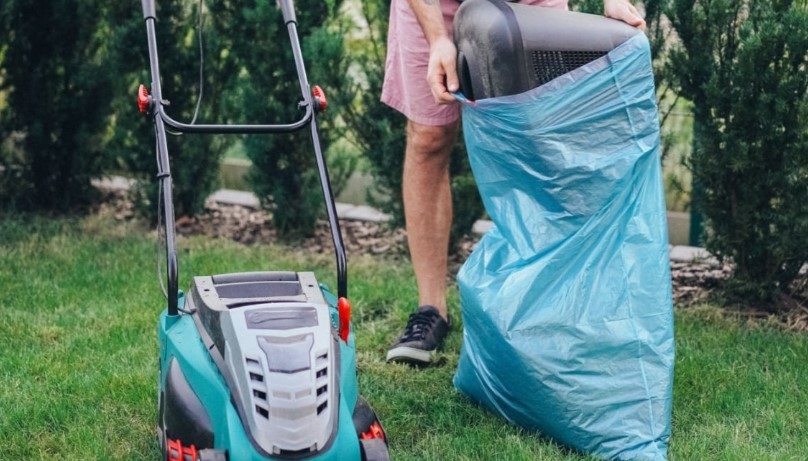How to Clean a Lawn Mower Grass Bag in Easy 6 Steps
Maintaining a pristine and healthy lawn involves more than just regular mowing; it requires proper care of your lawn equipment as well. One often overlooked but crucial aspect is cleaning the lawn mower grass bag. In addition to ensuring effective grass collection, a clean grass bag helps to prolong the life of your mower and maintain the general health of your lawn.
In this guide, we’ll help you discover how to clean a lawn mower grass bag in a decoded manner, enabling you to keep your lawn in top-notch condition. So, join Bebest to delve into the world of lawn mower care and unveil the secrets to a perfectly maintained grass bag.
Steps to Clean a Lawn Mower Grass Bag
A lawn mower grass bag serves as a practical accessory, diligently gathering grass clippings and bestowing upon your lawn a polished and orderly appearance. However, over time, the grass bag can become clogged with grime and debris, leading to diminished efficiency and an unpleasant odor. Regular cleaning is essential to maintain optimal functionality. Below, we outline the steps necessary for this endeavor:
Step 1: Prepare the Grass Bag
Before embarking on the cleaning process, it is crucial to properly prepare the grass bag. Begin by completely emptying the bag of all accumulated grass clippings and debris. To ensure thorough cleaning, invert the bag and apply a vigorous shaking motion, dislodging any dirt or dust that may have become embedded in the fabric.
For those more stubborn particles that resist easy removal, consider utilizing the effective tools at your disposal – a stiff brush can be wielded to loosen tenacious grime, or the gentle yet persuasive force of a garden hose can be employed to dislodge and wash away lingering contaminants. This preparatory stage is essential to ensure that the subsequent cleaning efforts yield the desired results, leaving the grass bag not only clean but also primed for optimal performance.

Step 2: Clear Fabric Pore Blockage
The fabric constituting the grass bag boasts an intricate network of minuscule pores that serve a vital function – allowing the passage of air. This ingenious design prevents the bag from succumbing to ruptures or damage under the pressure of accumulated grass clippings. However, the efficient functioning of these pores can be compromised over time as they become obstructed by a mixture of grass sap, dirt, and moisture.
This unfortunate congestion not only hinders the bag’s overall efficiency but also creates a conducive environment for the growth of mold and mildew, further undermining its utility. To rectify this issue, a comprehensive solution lies in immersing the grass bag in a receptacle filled with warm water, expertly blended with either a mild detergent or the tangy acidity of vinegar.
Allowing the bag to soak in this revitalizing concoction for a duration of approximately fifteen minutes initiates a process of dissolution, effectively breaking down and dislodging residual matter that has taken refuge within the fabric’s intricate matrix. As a result of this therapeutic immersion, the fabric emerges rejuvenated, its breathability restored, and its capacity for efficient air passage revived – a vital rejuvenation that ultimately contributes to the bag’s extended lifespan and sustained peak performance.
Step 3: Thorough Washing
Following the revitalizing soak, the grass bag is primed for a thorough washing – a pivotal step that significantly contributes to the bag’s overall cleanliness and functionality. This washing can be executed through one of two methods: the manual approach or the assistance of a washing machine. Should you opt for manual cleansing, enlist the aid of a soft sponge or cloth, accompanied by the mild detergent or vinegar solution previously employed.
With gentle yet deliberate strokes, lovingly scrub the bag’s surface, paying meticulous attention to every nook and cranny. Once satisfied with the extent of the cleaning, proceed to rinse the bag meticulously with a steady stream of clean water, ensuring the complete removal of any lingering cleaning agents or contaminants. With diligence, expel excess moisture from the fabric, allowing it to emerge from this process both immaculately cleansed and primed for the subsequent stages of revitalization.

Step 4: Vigorous Scrubbing
In the pursuit of pristine cleanliness, certain circumstances may demand a more robust and determined approach. Persistent stains or lingering odors, for instance, warrant a more potent cleansing agent. Commercial grass bag cleaners present a viable option, as they are specifically formulated to tackle such challenges.
Alternatively, for those who embrace a hands-on, DIY ethos, a homemade solution can be concocted. The simple yet effective mixture of baking soda and hydrogen peroxide, when combined within the confines of a spray bottle, yields a versatile and potent cleansing elixir. Applying this solution to stained or odorous regions of the grass bag and allowing it a brief reprieve of ten minutes paves the way for the deployment of a sturdy and steadfast brush – be it a purpose-built stiff brush or the dependable reliability of an old toothbrush.
With methodical determination, these tools are employed to vigorously scrub away the vestiges of stubborn blemishes, gradually coaxing the fabric back to its original, unblemished state. This vigorous scrubbing session, undertaken with precision and intent, constitutes a triumphant conquest over unsightly stains and unwelcome odors, heralding the restoration of the grass bag’s aesthetic appeal and functional integrity.
Step 5: Addressing Stubborn Stains
In the event that certain tenacious stains continue to resist the thorough cleansing efforts exerted thus far, a realm of alternative methods beckons, each offering a unique approach to stain elimination. The natural potency of lemon juice and white vinegar emerges as a dynamic duo, their combined forces effectively dismantling and bleaching away stubborn grass stains, evoking a renewed vibrancy within the fabric’s fibers.
For oil or grease-based blemishes that persist, the unyielding tenacity of rubbing alcohol or nail polish remover comes to the fore. These potent agents, harnessed with discernment and caution, exhibit an uncanny ability to dissolve and dislodge even the most obstinate of stains, rendering them inconspicuous and inconsequential.
Prudent execution of these methods entails a preliminary trial application upon a small, inconspicuous section of the fabric, safeguarding against unintended consequences and ensuring the continued integrity of the grass bag’s composition. Through these resourceful and strategic interventions, the grass bag is poised to emerge from this stage of the cleansing ritual, resplendent and unblemished, a testimony to the power of innovative stain removal.

Step 6: Thorough Drying
The culminating phase of the grass bag rejuvenation process centers upon the meticulous task of ensuring the bag attains a state of comprehensive dryness. This imperative step, executed with precision and care, sets the stage for the bag’s future endeavors – whether in storage or resuming its duties on the mower.
Various pathways lead to the desired outcome of absolute dryness: one option involves suspending the grass bag in an outdoor expanse imbued with the warm embrace of the sunlight, harnessing the sun’s radiant energy to facilitate a natural and thorough drying process. Alternatively, the sheltered confines of a well-ventilated indoor area may be enlisted for this purpose, ensuring a controlled and conducive environment for moisture evaporation.
For those inclined toward expedience, the gentle warmth of a dryer set to a low heat mode presents an efficient means of expelling residual moisture. Whichever avenue is chosen, the cardinal principle remains unwavering – the grass bag must emerge from this phase of the cleansing journey utterly devoid of dampness. This resolute commitment to complete dryness stands as a bulwark against the insidious infiltration of mold and mildew, safeguarding the bag’s condition and prolonging its functional vitality.
Maintenance Schedule
Recommendations for Cleaning Frequency
Keeping your grass bag clean benefits not only your lawn mower but also your lawn and the environment. A dirty grass bag can reduce mower efficiency, cause clogging and damage, and spread unwanted seeds and weeds. It can also create odors and attract pests. Therefore, clean your grass bag regularly. How often depends on factors like lawn size, grass type, weather, and mowing frequency. Generally, clean it after every mowing session or at least once a week. This prevents the buildup of clippings, dirt, and moisture, ensuring the bag’s longevity.
Here are some tips for effective and safe grass bag cleaning:
- To safeguard yourself from allergies, dust, mold, or germs, always put on gloves and a mask.
- Empty the bag promptly after mowing, ideally into a compost bin or designated area away from the lawn.
- Shake out any leftover cuttings before thoroughly rinsing the bag with a hose or pressure washer. Mild soap or detergent can remove stains and odors.
- Fully air dry the grass bag before storage or reuse. Hang it in sunlight or use a hair dryer, avoiding storage when wet to prevent mold and mildew.
- Check for wear and tear, such as holes or loose stitches, and replace if needed. Follow manufacturer instructions for your mower and grass bag.

Importance of Regular Maintenance for Lawn Mower Performance
Proper care ensures a longer-lasting, more efficient lawn mower. Regular maintenance is crucial for optimal performance. Here’s why you shouldn’t overlook this task:
- Prevent breakdowns and costly repairs by checking and replacing oil, spark plugs, air filters, blades, etc.
- Improve fuel economy and reduce emissions, saving money and benefiting the environment.
- Enhance lawn quality with evenly cut grass, clean airflow, and optimal combustion.
- Extend the mower’s lifespan by following manufacturer recommendations and performing routine checks.
- Regular maintenance ensures smoother mowing, a healthier lawn, and a more reliable experience. Start taking care of your lawn mower today for lasting benefits.
FAQs
If you love your lawn, you probably also love your lawn mower. But do you know how to take care of it properly? One of the most important parts of your mower is the grass bag, which collects the clippings and keeps your lawn neat and tidy. But if you don’t clean it regularly, it can get clogged, smelly, and even damage your mower. Here are some frequently asked questions and answers about how to clean a lawn mower grass bag.
Q: How often should I clean my grass bag?
A: It depends on how often you use your mower and how wet or dry the grass is. A good rule of thumb is to clean it every three or four mows or whenever you notice a decrease in suction or performance.
Q: How do I clean my grass bag?
A: First, make sure your mower is turned off and unplugged. Then, remove the grass bag from the mower and empty it into a compost bin or trash can. Next, use a garden hose to spray the inside and outside of the bag, removing any dirt and debris. You can also use mild soap and a soft brush to scrub any stubborn stains. Before reattaching the bag to the mower, thoroughly rinse it and allow it to air dry.

Q: What are some tips to keep my grass bag in good condition?
A: Here are some simple ways to extend the life of your grass bag and prevent problems:
- Avoid mowing wet grass, as it can stick to the bag and cause mold and mildew.
- Store your mower in a dry and shaded place, and cover it with a tarp or a cloth to protect it from dust and moisture.
- Check your grass bag for any holes, tears, or cracks, and replace it if needed.
- Observe the manufacturer’s directions for the particular mower and grass bag model you have.
Conclusion
By following these simple steps, it is easy to learn how to clean a lawn mower grass bag. Regular cleaning not only prevents clippings and debris from accumulating, but it also helps in promoting good airflow and preventing the spread of diseases in your lawn.
Remember that a clean grass bag contributes to a healthier lawn by preventing the spread of diseases and promoting effective grass clippings distribution. Additionally, it ensures that the lawn mower operates at its best efficiency. By following these steps and incorporating regular maintenance, you’ll be able to enjoy a well-kept lawn that’s the envy of the neighborhood.
Related Articles